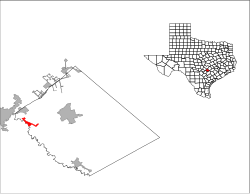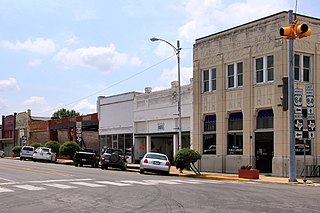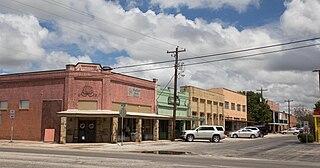Martindale, Texas | |
|---|---|
 Downtown Martindale. | |
 Location of Martindale, Texas | |
 | |
| Coordinates: 29°50′41″N97°50′21″W / 29.84472°N 97.83917°W | |
| Country | United States |
| State | Texas |
| County | Caldwell |
| Incorporated | 1982 |
| Area | |
| • Total | 2.09 sq mi (5.42 km2) |
| • Land | 2.06 sq mi (5.34 km2) |
| • Water | 0.03 sq mi (0.07 km2) |
| Elevation | 528 ft (161 m) |
| Population (2020) | |
| • Total | 1,253 |
| • Density | 596.70/sq mi (230.35/km2) |
| Time zone | UTC-6 (Central (CST)) |
| • Summer (DST) | UTC-5 (CDT) |
| ZIP code | 78655 |
| Area code | 512 |
| FIPS code | 48-46848 [3] |
| GNIS feature ID | 2411044 [2] |
| Website | http://www.martindale.texas.gov/ |
Martindale is a city in Caldwell County, Texas, United States. It is part of the Austin metropolitan area. The population was 1,253 at the 2020 census.
Contents
In recent years, Martindale has also attracted a surprising number of film scouts that have been attracted to the town's turn-of-the-century charm. As a result, various television shows, music videos and movies have been filmed in town most notably: A Perfect World, starring Clint Eastwood and Kevin Costner; The Newton Boys, starring Matthew McConaughey and Ethan Hawke; and New Line's 2003 remake of The Texas Chainsaw Massacre. Over the years, each subsequent film crew has left its mark on the town. A strand of wood beams sits on a vacant lot next to the bank—all that remains of a saloon that was constructed for one of the westerns.
In 2004, Carlton Carl, a Washington D.C. lobbyist, purchased 36,000 square feet (3,300 m2) of commercial property in downtown Martindale. A partial inventory of Carl's purchase includes three empty general stores, a former bank, a cotton-seed weigh station, several warehouses, a movie-set courtroom, an aquarium filled with cotton plants, a seed elevator, 16 seed silos and 300 feet (91 m) of frontage on the San Marcos River. Carl has been working closely with the residents of Martindale to plan the next phase of the town's rejuvenation.

In Fall 2007, Carl worked with students at Texas State University of San Marcos in the Interior Design program, under the guidance of Assistant Professor and Program Coordinator Nancy Granato, to receive help envisioning further planning of the town. The project entailed assigning each group of students a specific building (i.e. silos, weigh station, etc.) to redesign the interior of and to think of a possible business that would work well with the space. One group worked on the landscape plan of the town in relation to planting native species of trees and plants, creating a city park, putting in new sidewalks and outdoor lighting. The ideas were then presented to Carl as well as some of the residents and leaders of the town. [4] Students in the MBA program, under the guidance of Associate Professor Bob Hill, also presented Carl with a market analysis for the town of Martindale, TX. The presentation included an examination of the business district and potential economic opportunities; analysis of economic trends and activities to drive growth; and the identification new retail and restaurant opportunities. [5]















